
This is a list of the National Register of Historic Places listings in Greenville, South Carolina.

Butler Chapel A.M.E. Zion Church is a historic African Methodist Episcopal Zion Church built in 1913, and located in Greenville, Alabama. It was one of three significant meeting places for African-Americans living in Greenville during the early-20th century.
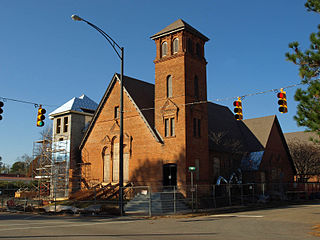
First Presbyterian Church is a historic Presbyterian church at 215 East Commerce Street in Greenville, Alabama. It was built in 1886 and added to the National Register of Historic Places in 1986. The church is a member of the Presbyterian Church in America.

The Buell–Stallings–Stewart House is a historic residence in Greenville, Alabama. The house was built in 1874 by a local lawyer David Buell, who later sold it to U. S. Congressman Jesse F. Stallings. Stallings sold the house to A. Graham Stewart, a local merchant, in 1901. The house is built in a Carpenter Gothic style, rare in Alabama, and features a steeply sloped roof and several sharply pointed gables and dormers. A flat-roofed, octagonal porch projects over the front entry. Each window and door is topped with a decorative Gothic arch molding with a diamond in the middle. The house was listed on the National Register of Historic Places in 1986.

Greenville City Hall in Greenville, Alabama is a historic city hall. The building was designed by Montgomery architect Moreland Griffith Smith, and built in 1936–37 by workers from the Works Progress Administration. The building is designed in a Colonial Revival style with Palladian influences, a popular style in the 1930s due to the recent restoration of Colonial Williamsburg. It was built on the site of a grammar school that was originally built in the 1890s, but burned in the early 1920s and again in 1927. The building is constructed of brick, with a full-height portico around the main entry. Each window on the first floor is topped with an ashlar keystone. The corners of the main block are adorned with stone quoins. The building was listed on the National Register of Historic Places in 1986.

The Colonel O. R. Hood House is a historic residence in Gadsden, Alabama. The house was built in 1904 by Oliver Roland Hood, an attorney, politician, industrialist, and one of the founders of the Alabama Power Company. He was also a delegate to the state's 1901 constitutional convention. It was designed and constructed by architect/builder James Crisman. Upon Hood's death in 1951, the house was purchased by the Woman's Club of Gadsden, a community service organization. The house is built in Classical Revival style with some Victorian details. The façade is dominated by a double-height portico supported by four Ionic columns. The front door is flanked by wide sidelights and a tall transom. The house also has two side entrances on octagonal bays at the rear of each side. The house was listed on the Alabama Register of Landmarks and Heritage in 1985 and the National Register of Historic Places in 1986.

The W. S. Blackwell House is a historic residence located at 211 Ft. Dale Street in Greenville, Alabama. The house was built around 1930, on land previously occupied by W. S. Blackwell's father-in-law's house, which burned in the 1920s.

The Commerce Street Residential Historic District is a historic district in Greenville, Alabama. The district consists of four houses along Commerce Street, constructed between 1846 and 1895. They represent the final and last remaining residential construction on the town's main street.

Confederate Park is a park in Greenville, Alabama. The park was established in 1902 in front of the First Methodist Church on 1 acre of land donated by the church to the United Daughters of the Confederacy. The following year, the UDC commissioned a 16-foot (4.8-m) marble statue of a Confederate soldier on a pedestal. In the following years, many shrubs and shade trees were planted, and in 1909 a fountain was donated by Mayor Claude E. Hamilton, and was placed in the center of the park. Sidewalks along Commerce Street and diagonal walkways through the park, as well as several benches, were also placed. In the 1920s, a landscape architect was hired to place flowers and evergreens. In 1937, the city hall was built across Commerce Street from the park.

Orange Vale, also known as the Lawler-Whiting House, is a Greek Revival plantation house completed in 1854 near Talladega, Alabama. The house was the centerpiece of a 3,000-acre (1,200 ha) cotton plantation, a forced-labor farm worked by black people enslaved by the land's white owners.
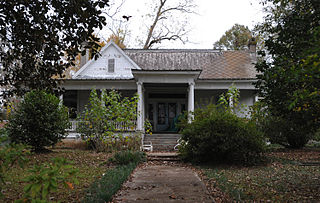
The Dickenson House is a historic residence in Greenville, Alabama. The house is an example of South Alabama vernacular architecture, with a truncated pyramidal roof topped with a flat platform. The house has a wrap-around front porch supported by Ionic columns. A cross-gable dormer with a vent adorns the left side of the façade. The main entry has Eastlake detailing, a transom, and sidelights. The interior features Queen Anne details including horizontally-paneled doors and paneled wainscoting.
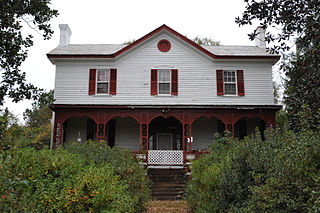
The Evens-McMullan House is a historic residence in Greenville, Alabama. It was built in the late 1860s by Holden Evens, a lumberman who specially selected the timber used in its construction. It was purchased in 1891 by Frank McMullen, a Greenville jeweler.
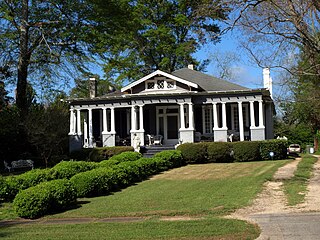
The Fort Dale-College Street Historic District is a historic district in Greenville, Alabama. The district contains Greenville's oldest existing affluent residences, dating to as early as the 1850s. In the initial federal land sale following the Creek War, the area that became northwest Greenville was claimed by William Dunklin. Dunklin sold the claim to William Burnette, who began to parcel the land for sale and to give to family members. Burnette's daughter and son-in-law built a Corinthian-columned Greek Revival home in 1857. A few other pre-Civil War houses remain, and construction continued after the war, including a school building that was later converted into a house. Most of the early residences were large, and built in Greek Revival, Second Empire, and Colonial Revival styles. Beginning in the 20th century, bungalows and cottages on smaller lots began to emerge. One of the later constructions in the district is a Spanish Colonial Revival house, built in 1928.
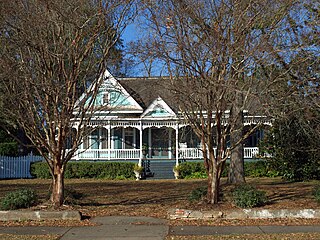
The Gaston-Perdue House is a historic residence in Greenville, Alabama. The house was built in 1895 by Butler County probate judge Zell Gaston. In 1903, following his term, Gaston moved to Birmingham and sold the house to physician J. L. Perdue.
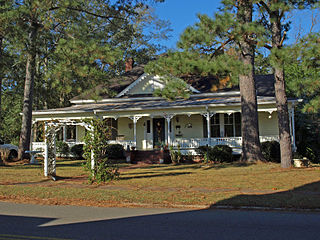
The Graydon House is a historic residence in Greenville, Alabama. The house was built in 1909, and typifies the southern Alabama vernacular house, with a hip roof and wrap-around porch. A gabled dormer is centered on the façade, and the porch has slender columns with elaborate brackets. Decorative woodwork continues inside, including Queen Anne fireplace mantels.

The Greenville Public School Complex is a historic school in Greenville, Alabama. Butler County High School was built in 1925 as a consolidated school serving the entire county. A second builing to house Walter O. Parmer Elementary School was completed on the same site in 1927. In 1937–38, the Public Works Administration constructed an auditorium, cafeteria, and manual arts training building. The high school was later renamed Greenville High School and has since relocated to a site along Interstate 65. A new building was constructed on site, and the campus is still used for Parmer Elementary.

The Hawthorne–Cowart House is a historic residence in Greenville, Alabama. It was built in the 1850s and purchased by A. J. Hawthorne in the early 1870s. It was sold to S. D. Cowart in 1901. The house is a one-story Vernacular building, constructed of wood and resting on brick piers. It has a gable roof with a cross-gable rear ell. The façade is five bays wide, and has a recessed porch supported by square columns. The interior has a center-hall plan with simple Greek Revival mantels and other details.

The House at 308 South Street was a historic residence in Greenville, Alabama. The house was built around 1890 and shared a corner lot with the McMullan–Skinner House. The house was a single-story, three-bay frame structure, with a gable roof and a shed-roofed front porch. The interior was a center-hall plan. The house was listed on the National Register of Historic Places in 1986, and demolished sometime before 2008.

The McMullan–Skinner House was a historic residence in Greenville, Alabama. The house was built around 1890 and shared a corner lot with the House at 308 South Street. It was a gable-roofed one-and-a-half story house with an inset front porch. The interior had a double-pen plan, with the originally detached kitchen connected to the house through an enclosed porch. The house was listed on the National Register of Historic Places in 1986, and demolished sometime before 2008.
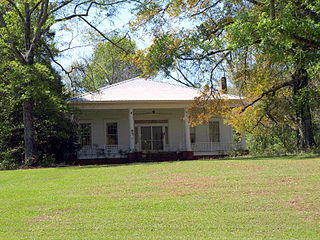
The John W. Howard House is a historic residence near Greenville, Alabama. It was built around 1860 by planter John W. Howard. While much of the land was sold off and used for timber, Howard's family continued to occupy the house at least through 1992. The house is a one story, Greek Revival structure with an inset front porch. The façade is five bays wide, and the central entrance has double doors with multi-light sidelights and transom. The interior is a triple-pile center-hall plan. Outbuildings include a frame barn, a two-room detached kitchen, and the family cemetery.






















